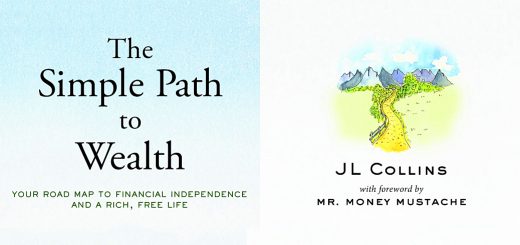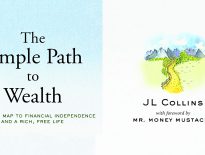Simple Path to Wealth 3 – TRFs, Vanguard, Tax Shelters

Today’s post is our third visit to The Simple Path To Wealth, by JL Collins.
Contents
TRFs
Chapter 16 is about Target Retirement Funds (TRFs).
- These are funds which automatically change your asset allocation (adding more bonds and taking away stocks) as your age moves towards your pre-defined target retirement ages.
I’m not a fan of TRFs, which are a reflection of the “your age in bonds” philosophy.
Without diverting this article too far into a discussion of retirement, what people used to do when they quit work was turn their pension pot into an annuity (an exchange of your cash now for regular payments in the future).
- This is in effect what DB and state pensions do, too, but in these cases, the price of the annuity is underwritten by the provider (the state, or your ex-employer).
Because of this, fluctuations in the value of your pension pot around retirement age could be very harmful, and people used to switch out of stocks into bonds for protection.
In the real world, annuity rates are tied to bond yields, which are in turn driven by interest rates.
- Since I started my career, interest rates have collapsed, and the price of annuities has shot up.
- Annuity prices are usually expressed as a yield (return) on a fixed size pot (usually £100K in the UK), so these yields have collapsed.
Once the yield falls below my long term return target (3% real, minimum), I lose interest in a product.
- As I write this, the index-lined (real) yield on an annuity for a 55-year-old man is 1.63%.
So don’t buy an annuity – they offer terrible value.
Even if you’re not buying an annuity, you might want to reduce your exposure to stocks around retirement age, in order to protect against sequencing risk.
- This is the risk that your fund will be unable to recover from a market crash at the start of retirement.
Even so, I wouldn’t use TRFs for this – you have no control over the asset allocation in the first place, or the glide path.
- If you want to build a “bond tent” around your retirement age, do it manually.
Now let’s see what Jim has to say about TRFs.
He seems to like them and spends some time walking us through the options offered by Vanguard.
The TRFs ranging from 2020 to 2060 each hold only four funds:
- Total Stock Market Index Fund
- Total Bond Market Index Fund
- Total International Stock Market Index Fund
- Total International Bond Market Index Fund
To those four funds the TR 2010, 2015 and 2020 funds add the Short-Term Inflation-Protected Securities Index Fund.
Jim also suggests a workaround if you don’t like the glide path:
If you want a more conservative (greater percentage of bonds) approach, choose a date before your actual retirement. If you want more aggressive (greater percentage of stocks), just pick a later date.
Jim notes that TRFs are often mandatory in workplace pension schemes.
Alternatives to Vanguard
Chapter 17 looks at alternative funds to VTSAX and VBTLX.
- Most of this is US-focused and of little interest to us.
Chapter 18 explains why Jim is so keen on Vanguard.
- Let’s be straight – there’s nothing special about Vanguard.
If you use ETFs like me, sometimes they are the cheapest, and sometimes they aren’t.
- ETFs from iShares, State Street and others are also fine.
The Vanguard platform is cheap when you are starting out, but it restricts you to Vanguard’s funds.
- When you have a bigger pot, there are better options.
I own a few Vanguard ETFs, but I’ve never used their platform.
Jim’s main point is that Vanguard is client-owned (specifically, owned by the shareholders of its funds).
- This makes no difference to the funds you buy and isn’t even true if you live outside the US (only the American fund own the company).
On average, Vanguard funds are cheap, but that’s largely because they don’t offer some of the most expensive funds.
- We aren’t buying an average, so just choose the cheapest fund that meets your needs.
Sometimes, this will be a Vanguard fund.
- More often than not, it won’t.
I would also add that it’s generally a good idea to spread your investments across counterparties.
- So if more than say 33% of your money is with Vanguard, move some of it.
Tax shelters
Chapter 19 is about the 401(k), 403(b), TSP, IRA and Roth buckets.
- These are US constructs, so let’s talk about the UK equivalents instead.
You only need to worry about three things – your workplace pension, your SIPP and your ISA.
- Youngsters yet to buy a home can take advantage of government savings schemes like Help to Buy and LISAs, but these are not investments.
Your employer is forced to contribute 3% to your pension (on earnings between roughly £10K and £50K), and you have to contribute 5% yourself.
- This 8% is nowhere near enough – target at least 15% – so if your employer offers further matching (aka free money), take advantage.
Your next port of call is your SIPP, to which you can contribute £40K pa (less your workplace pension contributions).
You get tax relief on your SIPP contributions (as on your workplace pension contributions), so this is an unbeatable savings product.
- Do your own research into SIPP vs ISA comparisons, but it’s impossible for ISAS to come out ahead (start here).
There are only three reasons for not filling up your SIPP allowance each year:
- you don’t have any spare money
- you are scared of locking away your money until you hit 55 (in which case you may not be suited to long-term investment)
- you have projected that you will hit the lifetime allowance (LTA) on your SIPP (currently £1.07M).
The LTA is an abomination, as contributions have already been capped on the way in, and there’s no way of knowing what level of future benefits your pension pot will deliver.
- So you’ll have to weigh up the risks for yourself.
Personally, I carried on contributing right up to the wire, hoping a future market crash would bail me out.
- The value is assessed when you move from accumulation into drawdown, so moving when values are low can help.
Once you’re done with your SIPP, put the rest of your spare cash in an ISA (annual allowance currently £20K).
- When your SIPP is full, there are other tax shelters you can consider (principally VCTs and EIS).
And we each have an annual allowance of £2K of dividends and £12.3K of capital gains, which supports a taxable share portfolio of around £100K.
As well as sheltering capital gains and dividends, SIPPs and ISAs have one other great advantage – no paperwork needs to be saved (in accumulation) as they don’t feature on your tax return.
- Pension drawdown is a bit more of a pain, but there’s no way around that at present.
American stuff
RMDs
Chapter 20 is about required minimum distributions (RMDs).
- These are mandatory amounts that must be taken from retirement pots, with 50% penalties for non-compliance.
They start at age 70 increase as you get older, with the objective of running your pot as close as safely possible before you die.
We don’t have them in the UK, but a similar consideration is the tax assessment of pension pots at age 75.
- It makes sense to withdrawal as mush money as is tax-efficiently possible before that age.
HSAs
Chapter 21 is about Health Savings Accounts (HSAs).
We have socialised medicine here in the UK, so you don’t need to worry about funding your own healthcare.
- Worry instead about paying for that of your less-healthy friends and neighbours.
Case study
Chapter 22 looks at a real-life reader case study from Jim’s blog (you can find it under “The Smoother Path to Wealth” on www.jlcollinsnh.com
- Again, this is too US-specific for us.
Investment advisors
Chapter 23 explains why Jim doesn’t like investment advisors:
- they don’t get better results
- they make things too complicated
- they are expensive
- they have a conflict of interest (the best result for them – good commissions – may not mean the best result for you – good returns)
- the industry attracts people who would like access to other people’s money
- learning to pick a good advisor (if any exists) is as much work as learning to invest for yourself
Over here in the UK, IFAs (independent financial advisors) are very expensive (thousands of pi=ounds for a few hours work).
- More importantly, they are not really IFAs.
Their training has a regulatory and client management focus, rather than concentrating on investment principles.
- Many of them outsource investment to platforms and asset managers, making them more like car salesmen than surgeons.
And the regulatory bias (fear of being disciplined) makes them way too conservative.
Conclusions
We covered another interesting set of chapters again today.
- There was less to disagree with, but more that was only relevant to US investors.
We’re three-quarters of the way through the book now, so there will be one more article in this series, plus a summary.
- Until next time.















IIRC, RMD’s now start at age 72.
Interestingly, RMD’s specify minimum withdrawals whereas GAD limits (a largely outdated UK regime) specified maximum withdrawals.
I think RMD’s main effect is to try to ensure that the US government should recover [some] taxation deferred during accumulation.